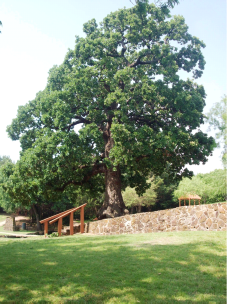FAMOUS TREES OF TEXAS
HOUSTON AMPSITE OAK
Historical Period: Republic of Texas (1836-1845)
Historical Topic: Native Americans, Politics & Politicians, Sam Houston
Species: Post Oak (Quercus stellata)
County: Dallas
Public Access: Yes
During his final term as President of the Texas Republic, one of Sam Houston’s major concerns was Indian relations. In 1843, a Grand Council of the Tribes comprised of Native American chiefs, Texas President Sam Houston, and several of his agents, arranged to meet at Grapevine Springs, in western Dallas County, to negotiate terms of the first peace treaty between the Republic of Texas and Native Americans. This council was supposed to take place months earlier but representatives failed to show. Houston was anxious this meeting would be a repeat.
Grapevine Springs is an area of rolling topography and native cross timbers woodlands. Scattered trees cast shade along the banks of spring-fed Elm Fork creek and create a beautiful camping spot. For weeks, Houston and his men camped while waiting for chiefs and commissioners to arrive. Other than the Comanches, expected parties did arrive and the council eventually concluded a peace treaty, signed at Birds Fort later that year.
Between the campground and the springs, just yards from the stream, a large post oak dominates the landscape. The Houston Campsite Oak is the crown jewel of what is now Grapevine Springs Park. Its leafy canopy filters sunlight, twinkling hues of green and gold.
In the 1930’s the Works Progress Administration built a stone retaining wall around the tree, likely to protect the slope from erosion. The Houston Campsite Oak continues to reign over the landscape as modern Texans hold council beneath its canopy.
Grapevine Springs Park is located at the end of Park Road Street off west Bethel Rd.
Historical Topic: Native Americans, Politics & Politicians, Sam Houston
Species: Post Oak (Quercus stellata)
County: Dallas
Public Access: Yes
During his final term as President of the Texas Republic, one of Sam Houston’s major concerns was Indian relations. In 1843, a Grand Council of the Tribes comprised of Native American chiefs, Texas President Sam Houston, and several of his agents, arranged to meet at Grapevine Springs, in western Dallas County, to negotiate terms of the first peace treaty between the Republic of Texas and Native Americans. This council was supposed to take place months earlier but representatives failed to show. Houston was anxious this meeting would be a repeat.
Grapevine Springs is an area of rolling topography and native cross timbers woodlands. Scattered trees cast shade along the banks of spring-fed Elm Fork creek and create a beautiful camping spot. For weeks, Houston and his men camped while waiting for chiefs and commissioners to arrive. Other than the Comanches, expected parties did arrive and the council eventually concluded a peace treaty, signed at Birds Fort later that year.
Between the campground and the springs, just yards from the stream, a large post oak dominates the landscape. The Houston Campsite Oak is the crown jewel of what is now Grapevine Springs Park. Its leafy canopy filters sunlight, twinkling hues of green and gold.
In the 1930’s the Works Progress Administration built a stone retaining wall around the tree, likely to protect the slope from erosion. The Houston Campsite Oak continues to reign over the landscape as modern Texans hold council beneath its canopy.
Grapevine Springs Park is located at the end of Park Road Street off west Bethel Rd.
COPPELL HISTORICAL SOCIETY, P.O. BOX 1871, COPPELL, TX 75019
[email protected]
The Coppell Historical Society is a 501 (c)(3) non-profit organization

